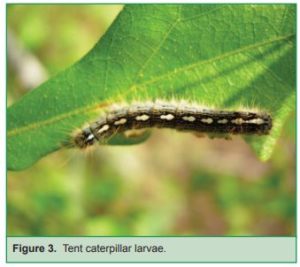My office receives a number of phone calls from citizens in surrounding areas in southern Brazoria County about this time of year describing large numbers of caterpillars that appear to cluster on outdoor walls, driveways and especially in the canopy of trees. County citizens are concerned with the large numbers of these insects and surprised at this occurrence, requesting information for insect eradication and prevention. This article is meant to help us learn a little bit more about the insect we have identified as Forest Tent Caterpillar (Malacosoma disstria) to make the most sustainable and environmentally friendly choices for our home and landscapes.
 Forest tent caterpillars are easy to recognize, exhibiting pale-blue and yellow lines extending along each side with a chain of distinct white shoeprint-shaped spots running down the middle of their back. The full life cycle is estimated up to six weeks, and by the time we see them they are well on their way to pupating into their adult stage as a dull brown moth. About this time of year and in early Spring is about the time we will begin to see activity and potential tree defoliation caused by the Forest Tent Caterpillar. This species has a life cycle coinciding with leaf emergence of Coastal Live Oak (Quercus virginiana). The larval (caterpillar) growth stage of the species can be found feeding on tender oak foliage as well as foliage of different tree species. They can also be seen covered on a cloak of webbing on outdoor surfaces such as the side of buildings, wheel wells or even roof of cars, seeming to cluster on just about any surface that doesn’t move. Contrary to its common name, the Forest Tent Caterpillar does not build a tent but spins a loosely woven mat along trunks and larger branches of trees. Dozens of caterpillars may congregate on these mats between feedings. You may also see webbed mats associated with their activity as they crawl along the side of your house.
Forest tent caterpillars are easy to recognize, exhibiting pale-blue and yellow lines extending along each side with a chain of distinct white shoeprint-shaped spots running down the middle of their back. The full life cycle is estimated up to six weeks, and by the time we see them they are well on their way to pupating into their adult stage as a dull brown moth. About this time of year and in early Spring is about the time we will begin to see activity and potential tree defoliation caused by the Forest Tent Caterpillar. This species has a life cycle coinciding with leaf emergence of Coastal Live Oak (Quercus virginiana). The larval (caterpillar) growth stage of the species can be found feeding on tender oak foliage as well as foliage of different tree species. They can also be seen covered on a cloak of webbing on outdoor surfaces such as the side of buildings, wheel wells or even roof of cars, seeming to cluster on just about any surface that doesn’t move. Contrary to its common name, the Forest Tent Caterpillar does not build a tent but spins a loosely woven mat along trunks and larger branches of trees. Dozens of caterpillars may congregate on these mats between feedings. You may also see webbed mats associated with their activity as they crawl along the side of your house.
While large or small populations of this caterpillar are disconcerting, emergence is an annual and natural cycle of reproduction for this native moth species; note this species reproduces one population each year around early April in our region. They may partially defoliate trees, and typically you will only see about 20% leaf loss and the tree will rebound quite nicely. With heavier infestations, there have been reports of complete defoliation, and deciduous trees typically re-leaf and rebound with a new flush of growth. From an article written by Texas A&M AgriLife Extension Entomologist Mike Merchant, stressors like drought, disease or physical damage from construction may compromise tree health, and trees may experience slowed growth or dieback of part of the tree with heavy defoliation.
My recommendation for a moderate or light infestation is to allow birds and other predators the opportunity to feed on these fascinating caterpillars. Caterpillar clusters can easily be washed off building and car surfaces with a garden hose. Least toxic insecticide use would include spot treatment of horticultural soap in solution, horticultural oil, or using products containing active ingredient Bacillus thuringiensis (Bt), a soil-borne bacteria that produces crystal proteins that dissolve in the insect gut, become active and punches holes in the gut lining and causing death within days. Be aware that the insect must ingest this product for it to be effective. Pyrethroid insecticides can also be used for control. Regardless of the kind of insecticide used, you must make sure the product comes in contact with the insect to be effective. Remember to always explicitly follow pesticide label instructions for application and observe warning indications for the safety of you and your environment.
Remember to assess the health of your tree and the kind of insect activity to act as your guide for methods taken interacting with the Forest Tent Caterpillar. Feel free to email me if I can answer any questions: sbrueggerhoff@tamu.edu. Take care and I’ll see you in the garden.
